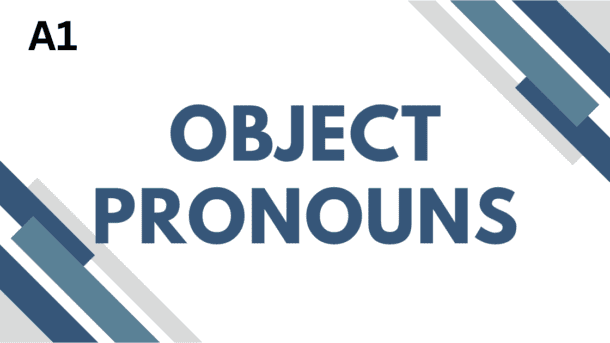Object pronouns are essential in understanding how to use English effectively. This lesson will explore the definition, uses, forms, and examples.
1. What are Object Pronouns?
Object pronouns are pronouns that receive the action of the verb in a sentence. They replace nouns that are the object of a verb or preposition to avoid repetition and provide clarity. In English, the primary object pronouns are:
- Me
- You
- Him
- Her
- It
- Us
- Them
Distinguishing Between Subject and Object Pronoun:
Before diving into object pronouns, it’s important to differentiate them from subject pronouns. Subject pronouns (I, you, he, she, it, we, they) act as the verb, while object pronouns receive that action.
Example:
- Subject pronoun: She eats an apple. (She is acting.)
- Object pronoun: The teacher gave her an apple. (Her is receiving the action.)
Examples of sentences
- Me: Can you help me with my homework?
- You: I saw you at the mall yesterday.
- Him: She called him after school.
- Her: I gave her a book for her birthday.
- It: Can you fix it for me?
- Us: They invited us to the party.
- Them: We will meet them at the concert.
2. The Forms of Object Pronouns
| Subject Pronoun | Object Pronoun |
|---|---|
| I | me |
| you | you |
| he | him |
| she | her |
| it | it |
| we | us |
| they | them |
3. A brief explanation of direct and indirect object pronouns
Direct Object Pronouns:
- Direct object pronouns are used to replace a noun that is receiving the action of a verb.
- Examples:
- I give her the book. (Here, “her” is the direct object pronoun replacing the noun “her”.)
- She is writing it. (Here, “it” is the direct object pronoun replacing the noun “the letter”.)
- Common direct object pronouns: me, you, him, her, it, us, them
Indirect Object Pronouns:
- Indirect object pronouns are used to show the recipient of the direct object.
- Examples:
- I gave the book to her. (Here, “her” is the indirect object pronoun showing who received the book.)
- He is sending it to them. (Here, “them” is the indirect object pronoun showing who is receiving the letter.)
- Common indirect object pronouns: me, you, him, her, it, us, them
4. Uses of Object Pronouns
As Objects of Verbs
Object pronouns directly follow the verb in a sentence, fulfilling the role of the recipient of the action.
Examples:
- Can you call me later?
- I saw him at the park.
- She loves her dog.
As Objects of Prepositions
Examples:
- The book is for you.
- I’ll go with them.
- This gift is from us.
In Questions
Object pronouns often appear in questions, where the speaker seeks information about someone receiving an action.
Examples:
- Who did you invite? (object pronoun: you)
- Did you see her yesterday?
- What did he tell me?
5. How to Use Object Pronouns
Understanding the correct usage of object pronouns helps in avoiding common mistakes. Here are some guidelines:
Agreement in Number and Gender
Object pronouns must agree in number (singular or plural) and gender (masculine, feminine, or neutral, when applicable) with the nouns they replace.
Examples:
- I saw him (singular and masculine).
- I gave her the message (singular and feminine).
- They invited us (plural).
Avoiding Repetition
Using object pronouns helps in avoiding repetition in sentences, making them smoother and more concise.
Example Without Object Pronoun:
- I saw John, and then I saw John again.
Example With Object Pronoun:
- I saw John, and then I saw him again.
6. Common Mistakes with Object Pronouns
Incorrect Pronoun Use
Using the wrong pronoun can change the meaning of a sentence.
Example:
- Incorrect: Me saw the movie last night.
- Correct: I saw the movie last night.
Mixing Up Subject and Object Pronouns
Students often confuse the two types of pronouns, particularly in complex sentences.
Example:
- Incorrect: The teacher helped I with my homework.
- Correct: The teacher helped me with my homework.
6. Practice Activities
6.1 Fill in the Blanks
Example:
- Please help ___ (I).
- The manager spoke to ___ (they).
- Can you send ___ (we) the report?
6.2 Rewriting Sentences
Example:
- Original: Sarah called the doctor.
- Rewritten: Sarah called him.
40 Example Sentences:
- She gave them a book.
- I will send it to you tomorrow.
- He is teaching us English.
- They are making her happy.
- We don’t know what you did with it.
- They are sending him a package.
- I will give them their grades.
- They are writing her a letter.
- She is calling them on the phone.
- I’m looking for something to read, but can’t find it.
- They are going to make us study harder.
- He gave me a book on my birthday.
- We will give them our report cards.
- Can you help them with their math homework?
- They are inviting her to the party.
- I’m feeling tired, so I’ll lie down, and give it to you when you get there.
- They are sending us to different classrooms.
- She is making me and her a sandwich.
- We will give it to you when we arrive.
- I saw him at the park yesterday.
- She gave me a wonderful gift for my birthday.
- Can you help us with our homework?
- They invited her to the party.
- I told them the news this morning.
- He bought it online last week.
- Please pass me the salt.
- She loves him very much.
- We need to call you later.
- I met her at the cafe.
- The teacher praised us for our hard work.
- I will call you tomorrow.
- He made it for her birthday.
- Please join us for dinner tonight.
- She asked him a question about the assignment.
- I saw you at the concert last week.
- They gave us their best wishes.
- It was hard for him to say goodbye.
- I bought you some flowers.
- She kept it a secret from everyone.
- Can you tell me more about them?
A sample dialogue about the school using object pronouns:
Emma: Hey, did you see the book I lent you?
Jake: Yes, I finished reading it yesterday. I really liked it!
Emma: I’m glad you enjoyed it! Can you give it back to me on Friday?
Jake: Of course! I’ll make sure to bring it with me.
Emma: Thanks! I appreciate you taking such good care of it.
Jake: No problem! I’ll take good care of your things anytime.
Tips for studying object pronouns:
- Learn the basics: Start by understanding what object pronouns are (me, you, him, her, it, us, them) and their functions in sentences.
- Identify the types: Familiarize yourself with direct object pronouns (receiving the action) and indirect object pronouns (receiving the direct object).
- Practice with sentences: Use example sentences to see how object pronouns are used in context, such as “She gave the book to me” (indirect object) and “I saw him” (direct object).
- Focus on pronoun placement: Learn where object pronouns typically appear in sentences, often after the verb or at the end of a sentence.
- Read and listen to examples: Read texts and listen to conversations that use pronouns, helping you become more comfortable with their usage.
- Review and reinforce regularly: Regularly review object pronouns to reinforce your learning and prevent confusion with other grammatical concepts.
Conclusion
Object pronouns are a fundamental aspect of English grammar that facilitates effective communication. Understanding how to use them properly will enhance both spoken and written English proficiency. Encourage consistent practice and provide ample opportunities for students to use what they’ve learned in meaningful contexts.
Study these A1 grammar lessons:
Verb To Be Negative Form
Verb To Be (AFFIRMATIVE FORM)
Pronouns ( Comprehensive Guide To Pronouns)
Singular and Plural Nouns
Numbers in English from 1 to 100
Articles ( A, An, The ) A COMPREHENSIVE GUIDE
English Numbers (1-20)
English Alphabet
How to use object pronouns in English
More Speaking & Vocabulary lessons:
School (A Comprehensive Speaking Guide for English Learners)
Daily Routine : A Comprehensive Guide for English Learners
The Weather In English
Talking About Hobbies and Interest
Family Members: A Comprehensive Guide for English Learners
Giving Personal Information In Eanglish
Fruit vocabulary In English
Parts of the Body in English
Days of the Week in English
Months in English




